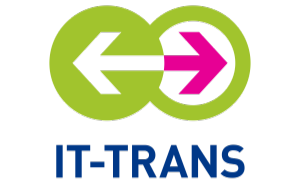The future on four wheels: How autonomous on-demand cabs are changing local transport
In focus: vehicles for digital and inclusive local transport.
Autonomous driving still sounds like the future to many. But in the C2Cbridge project, this vision is already in motion. In work package 3 “Vehicles”, we are developing user-friendly, networked, battery-powered electric cabs that can do more than just take up to four people from A to B. Our aim is to create a mobility service that can replace private cars. Especially where buses and trains have so far left gaps: on the way from rural areas to the city. What we have achieved so far and what steps will follow.
Why autonomous on-demand cabs?
How do we design means of transportation that are not only technologically sustainable, but also socially acceptable? This is the question that drives us. Our answer: vehicles that can be used individually, are barrier-free, comfortable and connected - and take everyone with them. Whether young people, senior citizens or people with limited mobility. With space for wheelchairs, baby carriages and luggage.
Two vehicles, one goal: research on the road
Two Mercedes-Benz EQVs, built in 2021 and 2023, form the backbone of our tests. Both are equipped with the same sensor technology for autonomous driving, but they take on different roles: While we have one specially converted to test comfort, accessibility and user interaction, the other drives in the slipstream as a “platooning” vehicle. This saves energy, creates safety and helps to use traffic space more efficiently.
The passenger seats have been removed in order to install the central hardware in the footwell to save space. To ensure that the technology runs reliably, it is connected directly to the air conditioning system - for stable cooling even under high computing loads.
A cab should not only drive, but also understand. That's why we integrate an infotainment system that is operated by tablet - with voice input, multilingual output, large font and simple menu navigation. Of course, the climate, lights and doors can also be controlled via the interface. And anyone who wants to can have vital data recorded via camera - voluntarily, of course.
From plan to implementation: the specifications
We have created specifications so that all technical and design requirements can be systematically implemented. They bundle all the planned changes to the vehicles - from the barrier-free entry solution to the automated control system and an individually adjustable air conditioning system. Infotainment and a functional yet atmospheric lighting concept are also part of the planning. The specifications help us to coordinate the integration of the subsystems internally, plan the conversions and manage progress in a structured manner.
3D and CAD: simulation meets reality
To enable us to plan, test and visualize better, we have digitally recorded the interiors of both vehicles. On this basis, we work with 3D models in Blender and CAD - not only for simulations, but also for use in other work packages. In addition, a 3D exterior model of the EQV helps us to integrate it into virtual test environments.
Rethinking comfort: chassis, climate and light
The chassis is also being adapted: Semi-active dampers, the optional air suspension and an optional roll stabilizer ensure a smooth driving experience. The lighting and climate control concept is integrated into the roof liner, made from sustainable lightweight material.
A special detail: A 360° thermal camera is integrated into the system, which detects signs of kinetosis - in other words, motion sickness. The camera provides information on the passengers' well-being and can later help to dynamically adjust the indoor climate - for example by controlling the temperature and lighting.
Technology that connects: the E/E architecture
Modern vehicles are data centers on wheels. We compare different E/E architecture concepts in order to intelligently network the multitude of components - from sensors to air conditioning. The goal is a central control system based on PREEvision. So that everything works together perfectly, from the door to the thermostat. At the same time, we systematically document all the necessary conversion measures for the electrical and electronic structure.
Outlook: What comes next
The next steps are already planned: Initial test drives and real-life trials are imminent. The sensors are being ordered and further activities relating to conversions and integration of the systems are being scheduled. We are keeping at it - step by step, test by test, journey by journey. Our goal: a genuine, inclusive alternative to the private car.
Country to City Bridge (C2CBridge) is embedded in the German Centre for Future Mobility (DZM) of the Federal Ministry of Transport and a flagship project in KAMO: Karlsruhe Mobility Ecosystem.
